Flavorful & Healthy Quinoa Pilaf: An Easy Gluten-Free Side Dish Recipe
Quinoa Pilaf offers a delightful and nutritious twist on the classic rice pilaf. By embracing the traditional preparation methods of toasting grains in butter and simmering them in rich broth with aromatic spices, we transform high-protein, gluten-free quinoa into an extraordinarily flavorful and healthy side dish. This simple yet elegant recipe promises a rich, aromatic, and satisfying addition to any meal, making it a staple for those seeking both taste and wellness.
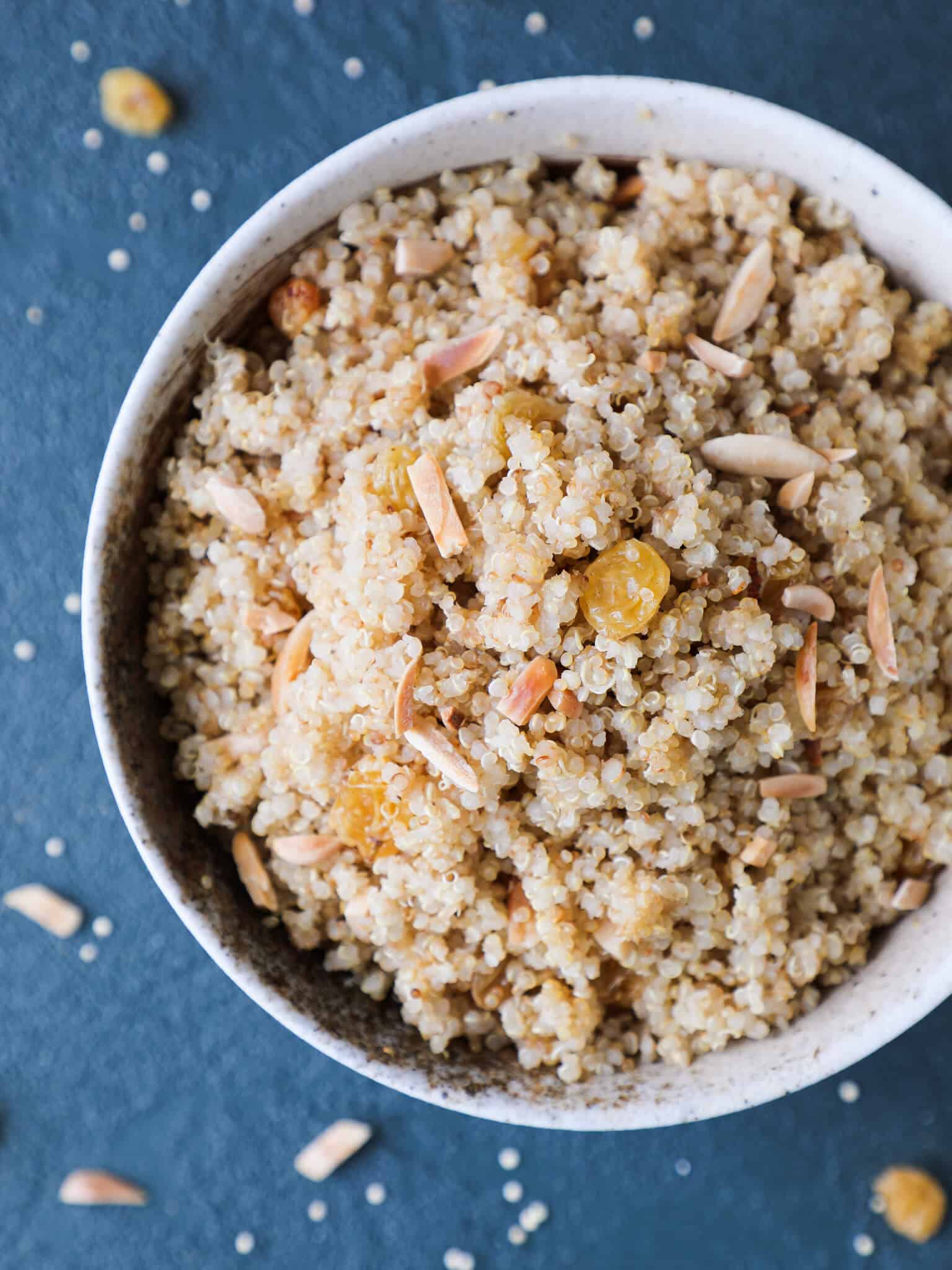
This effortless side dish leverages the quick-cooking nature of quinoa. The grains are first lovingly toasted in butter, imparting a nutty depth, then simmered with a blend of warming spices in a savory broth. While homemade chicken broth offers unparalleled richness, a good quality vegetable broth can easily make this a delicious vegan option. Quinoa pilaf is incredibly versatile, pairing beautifully with a wide array of main courses. I recently served it alongside a lemon roasted chicken and sheet pan roasted summer squash for a friend, creating a wholesome and comforting meal.
Beyond being a fantastic accompaniment, this quinoa pilaf truly shines with dishes that have a luscious sauce, allowing the grains to soak up all the delicious flavors. Imagine it with Spicy Peach Pork Chops, a refreshing Healthy Creamy Coleslaw, or a lightened-up Healthy Beef Stroganoff. The pilaf acts as a perfect canvas, bringing these meals together into a harmonious and deeply satisfying experience. I often prepare a larger batch of this versatile quinoa to use throughout the week in various recipes, such as a vibrant chickpea quinoa Greek salad, a hearty kale power bowl, or a refreshing roasted vegetable quinoa salad.
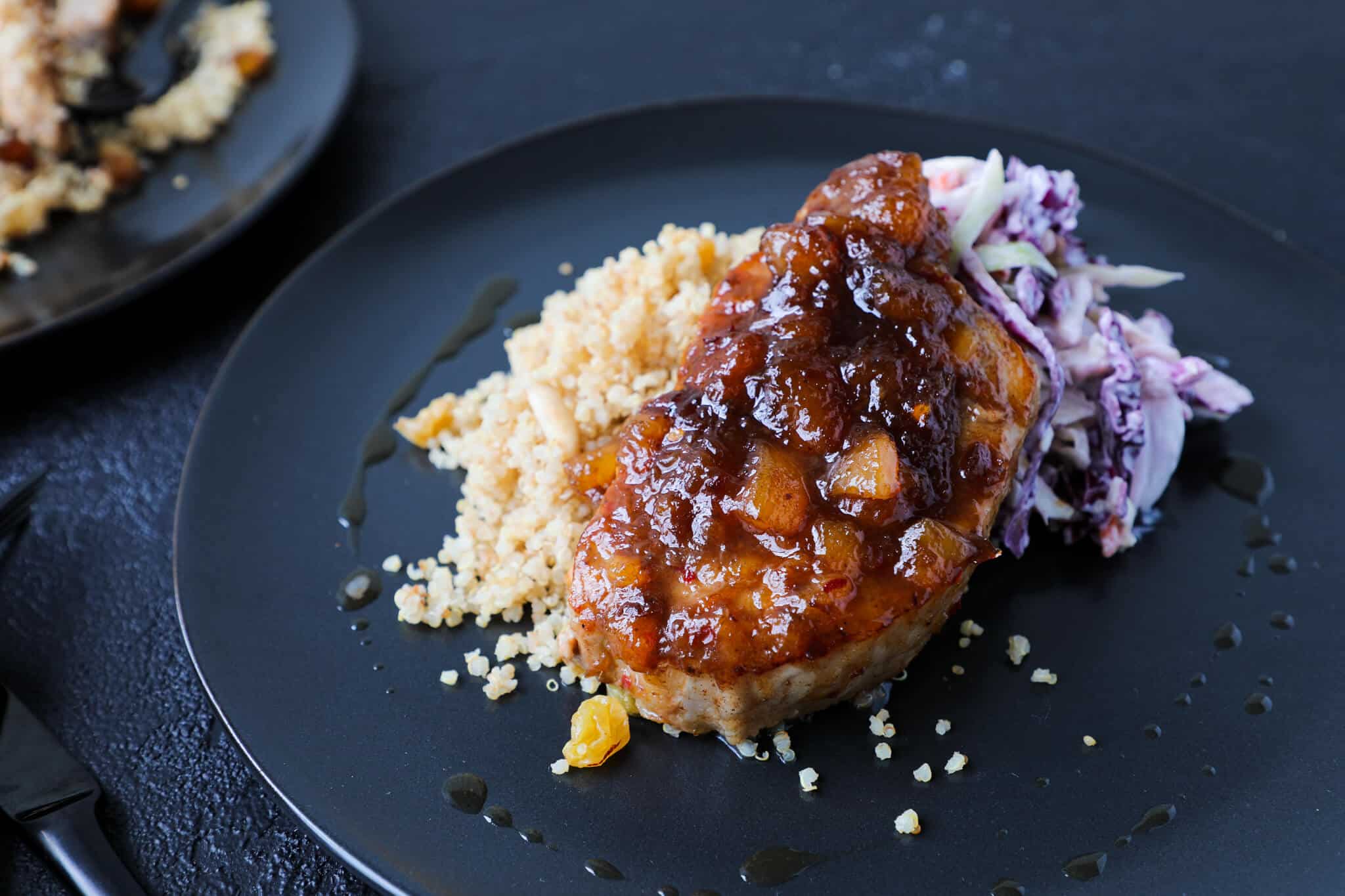
Table of Contents
- What Makes a Pilaf a Pilaf?
- What is Quinoa Pilaf?
- Why Quinoa is a Superfood
- Ingredients for the Perfect Pilaf
- Variations on Quinoa Pilaf
- Tips for Perfect Quinoa Pilaf
- How to Serve Quinoa Pilaf?
- Storage and Reheating
- Quinoa Pilaf Recipe
- Before You Go!
What Makes a Pilaf a Pilaf?
At its heart, a pilaf is more than just a grain dish; it’s a cooking technique that elevates simple ingredients into a symphony of flavors and textures. Traditionally, it involves two key steps: first, the grain (most often rice) is toasted in fat, typically butter or oil, until it achieves a nutty aroma and slightly browned appearance. This toasting process, known as ‘sauteing’ or ‘toasting the grain,’ is crucial as it helps to seal the grain, preventing it from becoming mushy and allowing it to absorb liquid more evenly, resulting in distinct, fluffy grains. The second defining characteristic is cooking the toasted grain in a flavorful liquid, such as stock or broth, often infused with whole spices like bay leaves, cinnamon, and cardamom. This method creates layers of subtle, nuanced flavors that permeate every grain, transforming an otherwise plain staple into a truly satisfying and delicious side dish that complements a wide variety of main courses.
What is Quinoa Pilaf?
Quinoa Pilaf is my innovative take on this ancient culinary tradition, adapting the revered preparation method of rice pilaf to the incredible, high-protein, and naturally gluten-free grain, quinoa. Instead of rice, I carefully toast the tiny quinoa grains in butter, enhancing their inherent nuttiness, before simmering them gently in rich chicken stock (or vegetable broth for a vegetarian option). The magic truly happens with the infusion of whole spices: a fragrant cinnamon stick, a savory bay leaf, and aromatic cardamom pods. These spices gently release their essential oils into the cooking liquid, imparting an exotic and deeply aromatic profile that perfectly complements the earthy notes of the quinoa. The result is a vibrant, protein-packed dish that’s not only incredibly delicious but also a powerhouse of nutrition, proving that healthy eating can be both easy and incredibly flavorful.
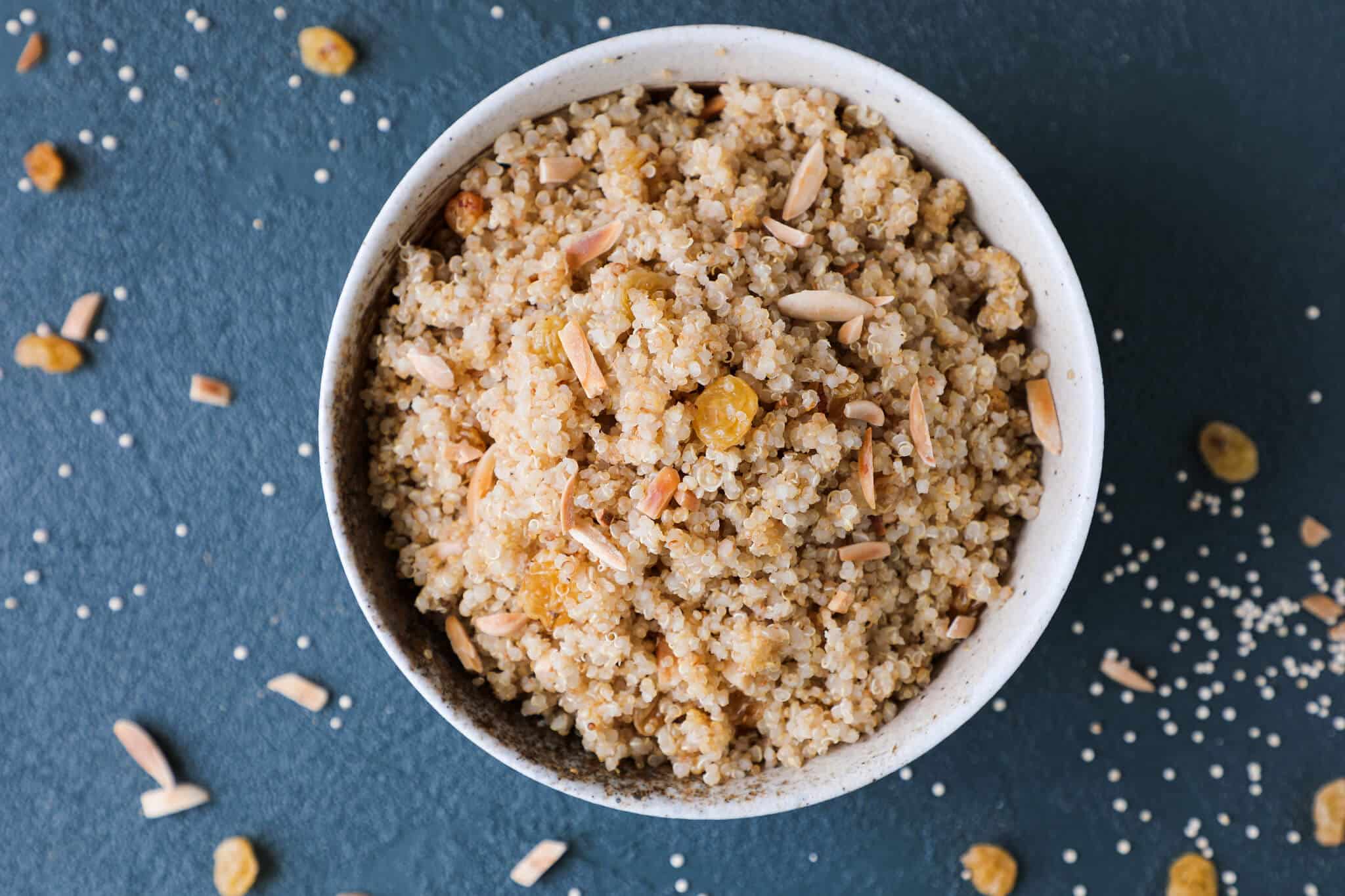
Why Quinoa is a Superfood
Often mistaken for a grain, quinoa is actually a seed from a plant related to spinach and beets, making it a “pseudocereal.” It’s celebrated worldwide as a superfood, and for good reason. Unlike most plant-based foods, quinoa is a complete protein, meaning it contains all nine essential amino acids that our bodies cannot produce on their own. This makes it an invaluable food source for vegetarians, vegans, and anyone looking to boost their protein intake. Furthermore, quinoa is naturally gluten-free, making it a safe and delicious option for individuals with celiac disease or gluten sensitivity.
But the benefits don’t stop there. Quinoa is also rich in fiber, which aids digestion, promotes satiety, and helps regulate blood sugar levels. It’s packed with essential vitamins and minerals, including magnesium, B vitamins, iron, potassium, calcium, phosphorus, and vitamin E. Its impressive nutritional profile contributes to heart health, bone density, and overall well-being. Choosing quinoa for your pilaf not only adds a unique texture and flavor but also significantly upgrades the nutritional value of your meal.
Ingredients for the Perfect Pilaf
Crafting a truly exceptional Quinoa Pilaf starts with understanding the role of each ingredient. Here’s a closer look at what makes this dish so special:
- Butter: I opt for unsalted butter as it gives me full control over the seasoning. Toasting the quinoa in butter provides a rich, nutty foundation that oil simply can’t replicate. It imparts a delightful aroma and deepens the overall flavor profile of the pilaf. If you’re vegan, a high-quality vegan butter substitute works wonderfully.
- Quinoa: The star of our show! While I typically use white quinoa for its delicate flavor and fluffy texture, don’t hesitate to experiment with red quinoa or even tri-color quinoa for added visual appeal and slightly different textures. Regardless of the color, always remember the golden rule for cooking quinoa: a 1:2 ratio of quinoa to liquid is essential for perfectly cooked, fluffy grains. Rinsing your quinoa thoroughly before cooking is also key to removing saponins, which can give it a bitter taste.
- Chicken Broth: This is where much of the pilaf’s deep, savory flavor comes from. Nothing quite compares to the nuanced richness of homemade chicken broth, but a high-quality store-bought chicken broth will also yield excellent results. For a vegetarian or vegan version, a robust vegetable broth is an ideal substitute, offering its own unique depth.
- Bay Leaf: A silent workhorse of flavor! Whether you use fresh or dried bay leaves, they contribute a delightfully subtle, savory, and slightly peppery aroma. It’s a flavor that’s hard to pinpoint individually but creates a noticeable void if missing from a dish. It adds a background layer of complexity that enhances the other spices.
- Cinnamon Stick: Whole cinnamon sticks are preferred over ground cinnamon here because they offer a gentle, gradual infusion of warm, sweet-spicy flavor without overwhelming the dish. They require simmering in liquid to truly release their fragrant oils, which then subtly perfume the quinoa.
- Cardamom Pods: These highly aromatic pods bring an exotic, floral, and slightly citrusy note to the pilaf. I particularly love white cardamom pods for their intense fragrance, but green ones are more commonly found and equally wonderful. If you can only find ground cardamom or seeds, use them very sparingly, as their flavor is much more concentrated and can quickly dominate the dish.
- Kosher Salt: Essential for balancing and enhancing all the flavors. Kosher salt has a larger crystal size and a less intense saltiness than table salt, making it easier to control the seasoning and prevent the dish from tasting flat or overly salty.
- Golden Raisins: These sweet gems add a delightful burst of sweetness and a chewy texture that contrasts beautifully with the savory, nutty quinoa. Golden raisins are typically a touch sweeter and fruitier than their darker counterparts, making them a perfect addition to this aromatic pilaf.
- Slivered Almonds: Toasted slivered almonds introduce a welcome crunch and a complementary nutty flavor. Toasting them beforehand enhances their aroma and texture, adding another layer of depth and interest to the finished pilaf.
Variations on Quinoa Pilaf
This Quinoa Pilaf recipe is a fantastic starting point, but its versatility truly shines when you begin to explore different variations. Here are a few ideas to inspire your culinary creativity:
- Vegetarian Quinoa Pilaf: Making this dish vegetarian is incredibly simple. Just swap the chicken stock for an equal amount of flavorful vegetable broth. You can further enhance its vegetarian appeal by stirring in sautéed vegetables like mushrooms, spinach, or bell peppers towards the end of cooking, or by adding a squeeze of fresh lemon juice for brightness. For a super easy approach, try adapting it for an instant pot, much like this instant pot rice pilaf recipe.
- Vegan Quinoa Pilaf: To make this pilaf completely vegan, you’ll need to make two simple substitutions. First, omit the butter or use your favorite vegan butter alternative for toasting the quinoa. Second, ensure you use vegetable broth instead of chicken stock. The whole spices will still provide plenty of depth and aroma, creating a truly delicious plant-based dish.
- Moroccan Quinoa Pilaf: Transport your taste buds to North Africa with this aromatic variation. Omit the cinnamon stick, bay leaf, and cardamom pods, and instead season the pilaf generously with a tablespoon of Ras el Hanout, a complex Moroccan spice blend. In place of golden raisins, incorporate chopped dried apricots or dates for a different kind of sweetness. A handful of toasted pistachios or a sprinkle of fresh cilantro at the end would further enhance this exotic flavor profile.
- Mediterranean Quinoa Pilaf: For a bright, herbaceous twist, skip the cinnamon and cardamom. Instead, add a pinch of dried oregano and a bay leaf to the broth. Once cooked, stir in fresh lemon zest, chopped fresh parsley, and a handful of crumbled feta cheese. You can also add chopped sun-dried tomatoes or Kalamata olives for an extra Mediterranean flair.
- Spicy Southwest Quinoa Pilaf: Give your pilaf a kick by incorporating Southwest flavors. Omit the whole spices. Toast the quinoa with a pinch of cumin and chili powder. Cook in vegetable broth, and once done, stir in canned black beans (rinsed), corn kernels, chopped cilantro, and a squeeze of lime juice. A diced jalapeño can be added with the quinoa for more heat.
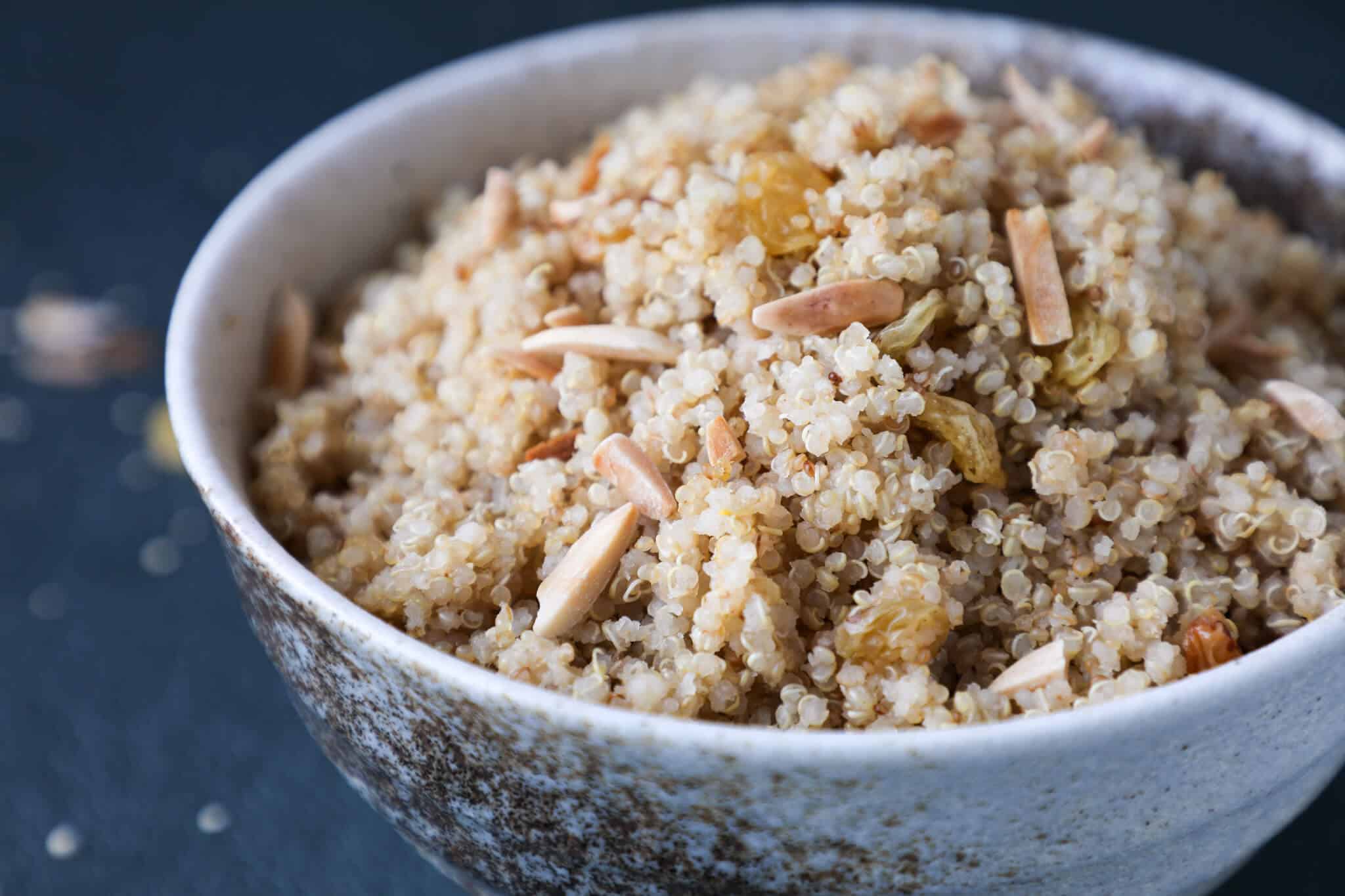
Tips for Perfect Quinoa Pilaf
Achieving perfectly fluffy and flavorful quinoa pilaf is easy with a few simple techniques:
- Rinse Your Quinoa: This step is often overlooked but crucial. Quinoa has a natural coating called saponin, which can impart a bitter, soapy taste. A quick rinse under cold running water in a fine-mesh sieve until the water runs clear will eliminate this bitterness and ensure a clean, pleasant flavor.
- Toast for Flavor: Don’t skip the step of toasting the dry quinoa in butter (or oil/vegan butter). This process, much like with rice pilaf, enhances the quinoa’s natural nuttiness, deepens its flavor, and helps create a more distinct, less gummy texture in the final dish. Toast until you smell a nutty aroma and see some grains lightly browned.
- Precise Liquid Ratio: The general rule of 1 cup quinoa to 2 cups liquid is key. Too much liquid will result in soggy quinoa, while too little will leave it undercooked and crunchy. Stick to this ratio for best results.
- Gentle Simmering: Once the liquid comes to a boil, reduce the heat to low, cover the pot tightly, and let it simmer gently. This allows the quinoa to absorb the liquid slowly and evenly, preventing it from boiling over or cooking too quickly on the outside while remaining raw inside.
- Don’t Peek or Stir: Resist the temptation to lift the lid or stir the quinoa while it’s simmering. Trapped steam is essential for even cooking. Stirring can also break the delicate grains and make the pilaf gummy.
- Rest After Cooking: Once the liquid is absorbed, remove the pot from the heat and let it rest, covered, for 5-10 minutes. This resting period allows the steam to redistribute, resulting in extra fluffy grains and prevents sticking.
- Fluff with a Fork: After resting, use a fork to gently fluff the quinoa. This separates the grains and incorporates air, giving your pilaf a light and airy texture.
How to Serve Quinoa Pilaf?
The beauty of Quinoa Pilaf lies in its incredible versatility. It can effortlessly transition from a humble side to the star of a vibrant main course. Here are some inspiring ways to serve this delicious dish:
- As a Dynamic Side Dish: Quinoa pilaf is a fantastic accompaniment to a wide array of main courses. Its aromatic and savory notes pair wonderfully with roasted meats like a juicy baked chicken and shallots, grilled lamb chops, or seared steak. It’s also excellent with delicate fish or rich, saucy pork dishes like the Spicy Peach Pork Chops mentioned earlier, where it expertly soaks up all the delicious pan juices. Don’t forget hearty vegetarian mains like lentil loaf or spiced chickpeas.
- The Heart of a Grain Bowl: Elevate your next grain bowl by using quinoa pilaf as the flavorful base. Its complex spices will add depth to every bite. Build layers of complementary flavors and textures: add a protein like rosemary chicken, grilled halloumi, or crispy chickpeas. Pile on roasted or fresh vegetables such as roasted cauliflower, bell peppers, or crisp greens. Finish with a drizzle of your favorite dressing, a sprinkle of crumbled feta cheese or toasted nuts, and perhaps a dollop of hummus or tzatziki for a complete and satisfying meal. Think about the combinations in a cherry burrata millet grain bowl and apply that creative spirit.
- As a Flavorful Vegetarian Entree: Quinoa pilaf can easily stand on its own as a hearty and healthy vegetarian main dish. Mix it with a colorful assortment of roasted vegetables such as zucchini, eggplant, cherry tomatoes, and sweet potatoes, as seen in this roasted vegetables quinoa chopped salad. Boost the protein further by incorporating seared tofu, tempeh, or a medley of sautéed mushrooms and lentils. A light sauce or a sprinkle of fresh herbs can tie all the elements together into a truly delicious and filling meal.
- Breakfast or Brunch Idea: Believe it or not, savory quinoa pilaf can make an interesting breakfast! Serve it topped with a fried egg, a handful of fresh avocado, and a dash of hot sauce for a unique and protein-rich morning meal.
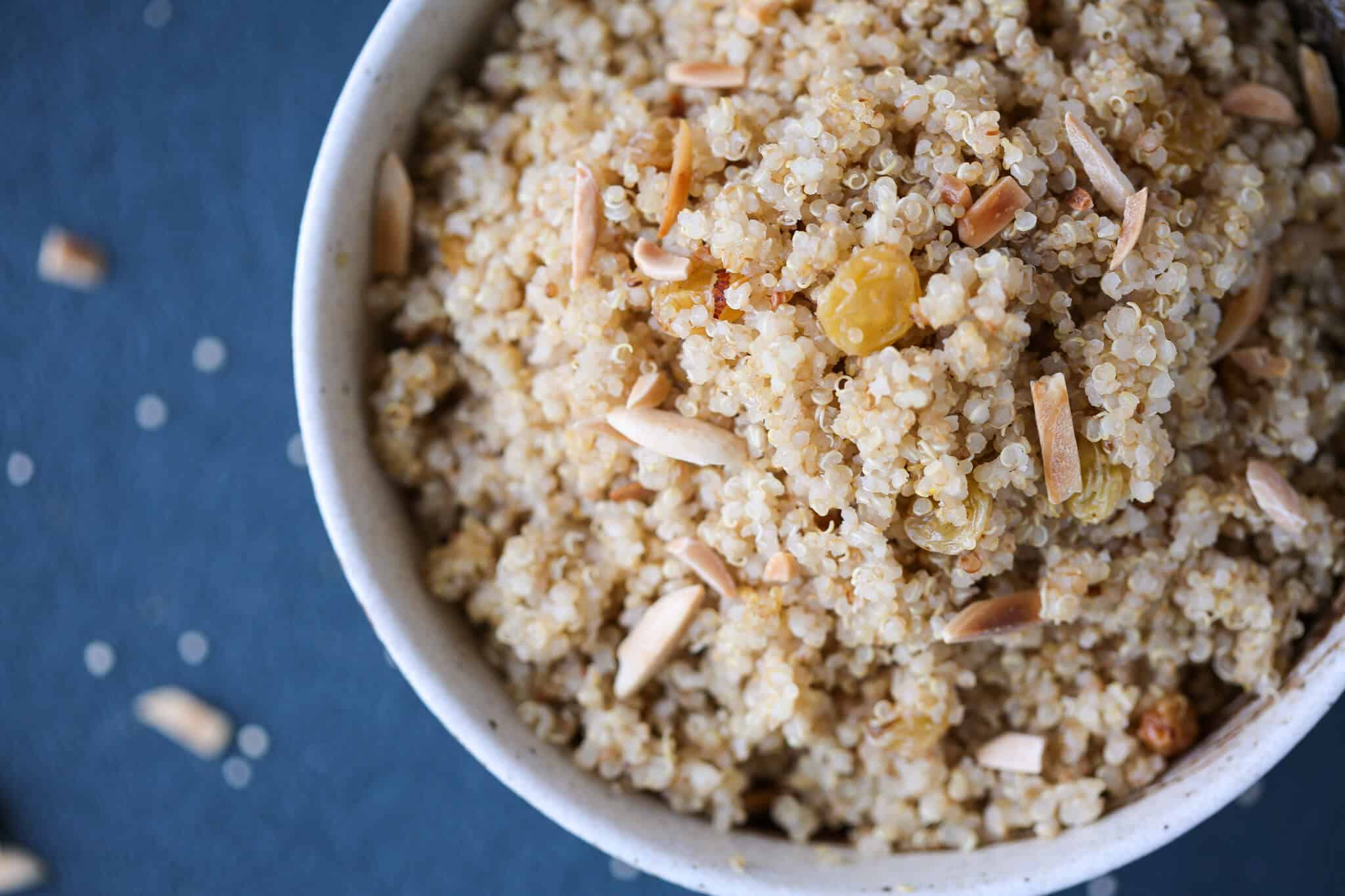
Storage and Reheating
One of the great advantages of Quinoa Pilaf is how well it stores, making it perfect for meal prep. Once completely cooled, transfer any leftovers to an airtight container and refrigerate for up to 3-4 days. To reheat, you can use a microwave (loosely covered) or a stovetop. If reheating on the stovetop, add a splash of water or broth to the pan, cover, and warm over low heat, stirring occasionally, until heated through. This helps to prevent the quinoa from drying out and maintains its lovely fluffy texture. Quinoa pilaf can also be frozen for up to 2-3 months. Thaw overnight in the refrigerator before reheating.
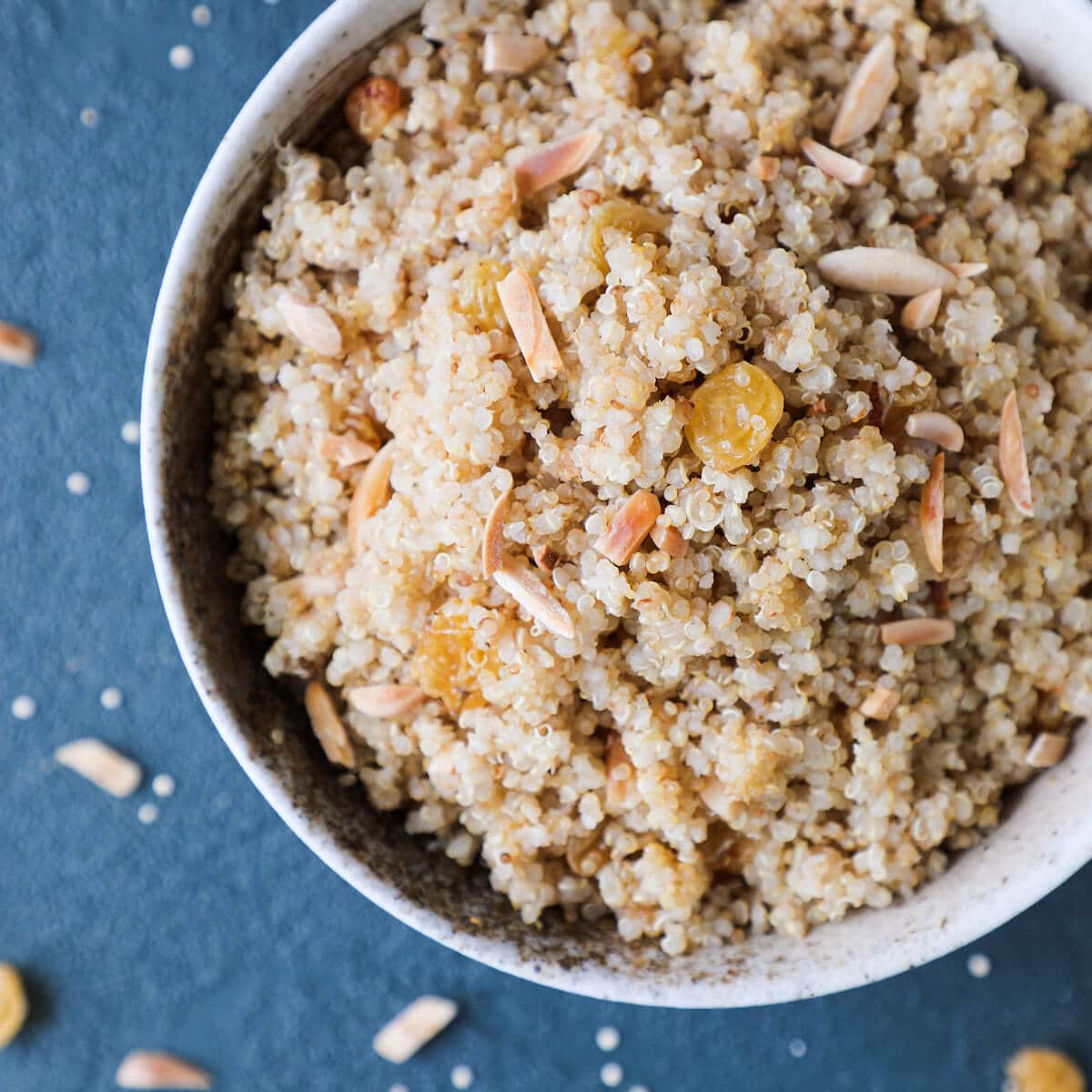
Quinoa Pilaf
Saved
Pin Recipe
Comment
Print Recipe
Equipment
-
All Clad 3 qt Pot
-
OXO Good Grips 3-Piece Wooden Utensil Set
-
Pyrex 32oz Liquid Measuring Cup
Ingredients
- 1 tablespoon Butter unsalted
- 1 cup Quinoa uncooked
- 2 cups Chicken Broth or vegetable broth
- 1 Bay Leaf dried or fresh
- 1 Cinnamon Stick
- 6 Cardamom Pods
- 1/8 teaspoon Kosher salt
- ¼ cup Golden Raisins
- ¼ cup Slivered Almonds toasted
Instructions
-
In a medium sauce pot, melt the butter then toast the quinoa over medium-low heat until most of the quinoa begins to brown and it smells a little nutty. The quinoa will also begin to pop, which is unavoidable.
-
Pour in broth and stir.
-
Add whole spices and return the pot to the heat. Cover and cook over medium heat until it comes to a boil. Reduce heat to low and simmer until all the water has been absorbed and the quinoa looks plump. The little tails on the grains will also pop out when fully cooked.
-
Fluff with a fork and then toss in the toasted almonds and golden raisins.
-
Transfer to a serving bowl and enjoy while hot.
Video
Notes
Nutrition
Carbohydrates: 26g |
Protein: 6g |
Fat: 6g |
Saturated Fat: 2g |
Polyunsaturated Fat: 2g |
Monounsaturated Fat: 2g |
Trans Fat: 0.1g |
Cholesterol: 7mg |
Sodium: 357mg |
Potassium: 277mg |
Fiber: 4g |
Sugar: 4g |
Vitamin A: 67IU |
Vitamin C: 1mg |
Calcium: 46mg |
Iron: 2mg
Like this? Leave a comment below!
Before You Go!
We hope you’ve enjoyed learning how to create this incredibly flavorful and healthy Quinoa Pilaf. It’s a dish that truly embodies the idea that wholesome food can be both simple to prepare and exquisitely delicious. Whether you serve it as a vibrant side or a hearty main, this pilaf is sure to impress.
Don’t stop here! Explore more of our delicious, chef-created recipes designed to inspire your home cooking. Dive into our collection of Side Dishes, where you’ll find other fantastic recipes like this refreshing shaved brussels sprout salad and many more culinary delights crafted to add flavor and nutrition to your table. Happy cooking!
